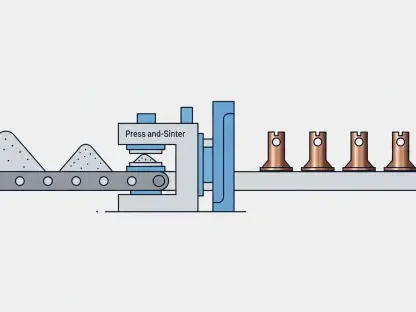The eurozone’s economic landscape is currently under significant strain, with the manufacturing sector at the heart of the turmoil. This article delves into the factors contributing to the manufacturing crisis and its implications for GDP stability in the eurozone. The complex interplay of inventory management, high energy costs, diverted investments, weak domestic demand, and external competition presents a multifaceted challenge that threatens the overall economic growth and stability of the region.
The Inventory Cycle’s Role in Manufacturing
Historical Context of Inventory Management
Historically, manufacturers have struggled to maintain optimal inventory levels. The advent of globalization and efficient supply chains led to reduced inventory-to-sales ratios. However, the Covid-19 pandemic disrupted these systems, exposing the risks of low inventory levels and prompting businesses to increase their inventories as a buffer against future disruptions. Manufacturers who once relied on just-in-time inventory strategies to minimize costs suddenly found themselves grappling with supply chain shocks that halted production lines and led to significant financial losses.
This shift towards increased inventories was not merely a knee-jerk reaction to a short-term crisis. The pandemic highlighted vulnerabilities in global supply chains that many businesses had previously overlooked. With supply chain reliability becoming a major concern, manufacturers began re-evaluating their strategies. The emphasis shifted from minimizing inventory costs to ensuring that sufficient stocks were available to weather future disruptions. Rising geopolitical tensions and concerns about the stability and reliability of cross-border trade relationships further amplified the necessity for higher inventory levels. These adjustments, while essential for supply chain resilience, come with substantial economic costs and macroeconomic implications.
Current Inventory Challenges
Today, manufacturers face the challenge of balancing sufficient stock levels with the high costs of maintaining inventories. Rising geopolitical tensions and concerns about cross-border trade stability further compel manufacturers to hold higher inventory levels. This delicate balance has significant macroeconomic implications, as inventory cycles can greatly influence GDP growth. Maintaining large inventories is expensive, involving costs related to storage, insurance, and the risk of obsolescence. Consequently, manufacturers must navigate the fine line between ensuring enough inventory to prevent production halts and avoiding the financial burden of holding excessive stock.
The cycle of inventory adjustments plays a crucial role in the broader economic picture. For context, inventory changes have historically contributed between -1.4 and 0.9 percentage points to year-on-year GDP growth on a quarterly basis since the inception of the Monetary Union. These figures underscore how inventory fluctuations can significantly skew economic performance metrics, making inventory management a critical factor for economists to monitor. As manufacturers grapple with these challenges, the broader eurozone economy remains sensitive to the ebbs and flows of inventory levels, with potential repercussions for overall GDP stability and growth trajectories.
Pessimism in the Manufacturing Sector
Impact of High Energy Prices
The eurozone’s manufacturing sector is grappling with persistently high energy prices, which have exacerbated the industry’s struggles. The Inflation Reduction Act (IRA) in the United States has redirected investments towards the U.S., reducing capital flows into European manufacturing and adding to the sector’s woes. High energy costs, driven by geopolitical instability and supply constraints, have put immense pressure on profit margins and operational viability within the manufacturing sector. This situation has been further compounded by energy market volatility, which has made it difficult for businesses to plan and budget effectively.
Manufacturers, particularly those in energy-intensive industries, find themselves in a bind as they navigate soaring energy costs while trying to maintain competitive pricing. This burden is significantly impacting their bottom lines and reducing their capacity to invest in new technologies or expand production capabilities. The resulting squeeze on finances is contributing to a pervasive sense of pessimism within the sector. Businesses are increasingly cautious about future investments, and this cautiousness is reflected in broader economic indicators that point to sluggish growth and constrained industrial activity. The high cost of energy is not just a short-term hurdle but a long-term challenge that has cascading effects across the entire manufacturing value chain.
Weak Domestic Demand and External Pressures
Domestic demand within the eurozone remains weak, further straining the manufacturing sector. Additionally, China is exporting its excess manufacturing capacity, increasing competitive pressures on eurozone manufacturers. This combination of factors has led to a significant decline in the added value in eurozone manufacturing since late 2022. The weak domestic demand is particularly concerning, as it limits manufacturers’ ability to sell their products within the region. This scenario forces businesses to rely more on export markets, which are already highly competitive and subject to their own set of challenges. The influx of cheaper goods from China exacerbates these challenges, making it difficult for local manufacturers to maintain market share.
The ongoing uncertainty over potential U.S. import tariffs adds another layer of complexity to the already fraught situation. With the possibility of additional trade barriers on the horizon, manufacturers are hesitant to make significant investments or long-term commitments, further stalling growth and innovation within the sector. The European Commission’s December survey highlighted weakened orders in the manufacturing sector, and the January flash PMI indicated that this trend was continuing. This deep-seated pessimism, fueled by both domestic and external pressures, casts a long shadow over the eurozone’s manufacturing outlook, making a swift recovery seem increasingly elusive.
The Impact on GDP Growth
Inventory Levels and GDP
High inventory levels are expected to negatively impact GDP growth in the eurozone. Elevated inventories, which often include a substantial import component, suggest that while net exports might slightly cushion the negative impact, they will not be enough to offset it entirely. As a result, eurozone GDP is likely to stagnate through the winter months. The macroeconomic implications of high inventories are profound. When businesses hold more inventory than needed, it often signals a slowdown in demand, leading to a cutback in production plans and adjustments in workforce requirements.
This scenario is problematic for GDP growth, as reduced production directly impacts the overall economic output. Recent surveys, including the European Commission’s December survey and the January flash PMI, indicate weakened orders in the manufacturing sector and an uptick in stock levels. This trend suggests that firms will focus on reducing existing inventories before ramping up production, further dampening GDP growth. When inventories are high, businesses prioritize liquidating these stocks, often through price reductions or slower purchases of new inputs, both of which contribute to a slowdown in economic activity. Consequently, the overhang of inventories in the eurozone’s manufacturing sector will likely continue to be a drag on GDP, prolonging the period of economic stagnation.
Survey Insights and Future Outlook
Recent surveys, including the European Commission’s December survey and the January flash PMI, indicate weakened orders in the manufacturing sector and an uptick in stock levels. This trend suggests that firms will focus on reducing existing inventories before ramping up production, further dampening GDP growth. The December survey revealed that order books are thin, with many companies experiencing a significant drop in new orders. The January flash PMI echoed this sentiment, pointing to a continued decline in manufacturing activity and an increase in unsold stock. This combination of factors puts businesses in a position where they must prioritize inventory reduction over new production.
As firms draw down excess inventory, the immediate impact on GDP will be negative, given the higher import component of these stocks. While the process of inventory liquidation can lead to disinflationary pressures, it simultaneously means lower production and, consequently, lower GDP contribution from the manufacturing sector. The outlook remains bleak, with no immediate signs of recovery. The eurozone’s manufacturing crisis is poised to persist, creating a substantial hurdle for economic growth. The high level of inventories, coupled with weak demand and external competitive pressures, makes a swift turnaround unlikely, suggesting that stagnation may extend into the coming months.
Inflation and High Inventories
Disinflationary Pressures
High inventories in non-energy goods may contribute to lower goods prices, offering a potential silver lining. Companies typically prioritize liquidating excess stock by accepting price reductions, which can help mitigate inflationary pressures. This disinflationary effect is particularly relevant in the context of the current economic climate, where high levels of inventory are evident across various sectors. As businesses strive to offload surplus goods, they often resort to discounts and promotions, which can temporarily ease inflation concerns for consumer goods.
However, this impact might be short-lived. Retail sector-specific surveys suggest that while inventories remain high, their influence on reducing goods inflation is diminishing. The downward pressure on prices from inventory liquidation is a finite process, and its effects are likely to taper off as stock levels are normalized. Therefore, while there may still be some disinflationary pressure from higher inventories, it is peaking and will not provide a sustained downward push on prices. This represents a short-term reprieve from inflationary woes rather than a long-term solution, and other factors, such as wage increases and supply chain adjustments, will continue to influence inflation dynamics moving forward.
Diminishing Impact on Inflation
Retail sector-specific surveys suggest that the impact of high inventories on reducing goods inflation is diminishing. While there may still be some disinflationary pressure from higher inventories, it is likely peaking and will not provide a sustained downward push on prices. The temporary nature of this disinflationary impact means that it is not a reliable indicator of long-term inflation trends. Once businesses have cleared their excess stock, the pricing dynamics will revert to being influenced by other factors such as production costs, labor market conditions, and global supply chain constraints.
As the immediate effects of inventory liquidation fade, the eurozone may find itself grappling with persistent inflationary pressures once again. This scenario underscores the complexities of the current economic environment, where short-term disinflationary trends coexist with longer-term inflationary risks. Businesses and policymakers must therefore remain vigilant, recognizing that while high inventories offer a temporary cushion against inflation, they do not address the underlying structural challenges. Moving forward, the eurozone will need to focus on enhancing productivity, ensuring energy affordability, and stabilizing supply chains to achieve more sustainable control over inflation.
Broader Economic Implications
Energy Costs and Investment Diversion
The eurozone’s manufacturing sector continues to be hampered by high energy costs and diverted investments due to U.S. policies. These factors contribute to a deeply ingrained pessimism within the sector, making a swift recovery unlikely. Energy costs remain a significant hurdle, with no immediate resolution in sight. The high cost of energy, driven by geopolitical tensions and market volatility, continues to erode the profitability of manufacturing operations. At the same time, policies such as the IRA have incentivized investments to shift towards the U.S., further depleting the eurozone’s manufacturing potential.
The diversion of capital away from Europe to other regions exacerbates existing investment shortfalls and stifles innovation within the manufacturing sector. It creates a cycle of underinvestment that is difficult to break, particularly in an environment of high operating costs and uncertain policy directions. This deeply ingrained pessimism is reflected in business sentiment surveys and economic indicators, which consistently point to a lack of confidence in the sector’s near-term prospects. Manufacturers remain cautious, limiting their capital expenditures and focusing on survival rather than expansion. This cautious stance translates into lower economic activity, reinforcing the stagnation scenario for the broader eurozone economy.
Competitive Pressures and Domestic Demand
Weak domestic demand and competitive pressures from abroad further exacerbate the manufacturing sector’s struggles. The uncertainty over potential U.S. import tariffs adds another layer of complexity, deterring investment and recovery efforts. The interplay of weak domestic consumption and strong external competition places eurozone manufacturers in a precarious position. With limited sales opportunities at home and aggressive competitors abroad, businesses are squeezed from both ends, finding it increasingly difficult to sustain operations at optimal levels.
The potential introduction of new U.S. tariffs poses an additional threat, casting a shadow of uncertainty over the sector’s future. Such tariffs could disrupt established trade relationships, increase costs, and further complicate supply chain logistics. This uncertainty makes long-term planning and investment even more challenging, stifling the sector’s recovery efforts. In the face of these challenges, the manufacturing sector’s prospects appear grim, with little room for maneuvering. The cumulative effect of these pressures underscores the critical need for strategic intervention and policy support to bolster the sector and safeguard the broader eurozone economy from prolonged stagnation.
Conclusion
The eurozone is facing significant economic challenges, with its manufacturing sector at the epicenter of this crisis. This turmoil has been exacerbated by a variety of factors that are putting immense pressure on the region’s GDP stability. Key issues include intricate inventory management problems, skyrocketing energy costs, and investments being funneled elsewhere. Additionally, the sector is grappling with weak domestic demand and intense external competition. Together, these challenges form a complex web of obstacles that jeopardize the economic growth and overall stability of the eurozone. As these issues continue to unfold, they reveal the vulnerability of the eurozone’s economic structure and the urgent need for strategic interventions to stabilize the manufacturing sector. Balancing these factors will be critical for ensuring that the region can sustain its economic momentum and avoid further downturns, highlighting the multifaceted nature of this ongoing economic struggle.









